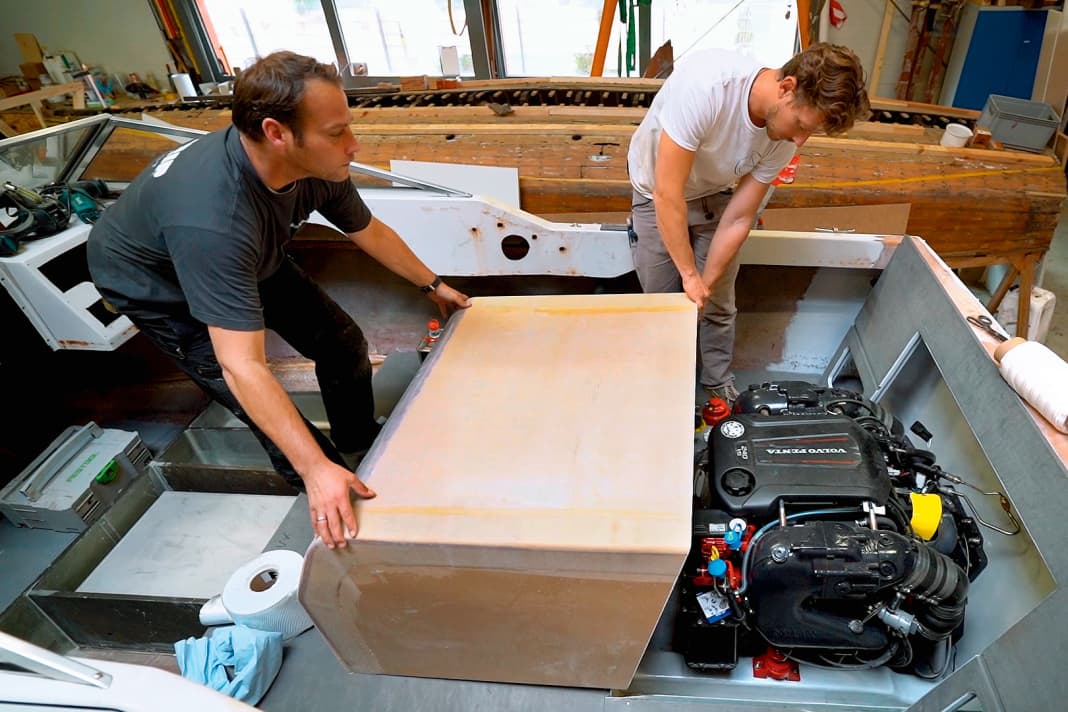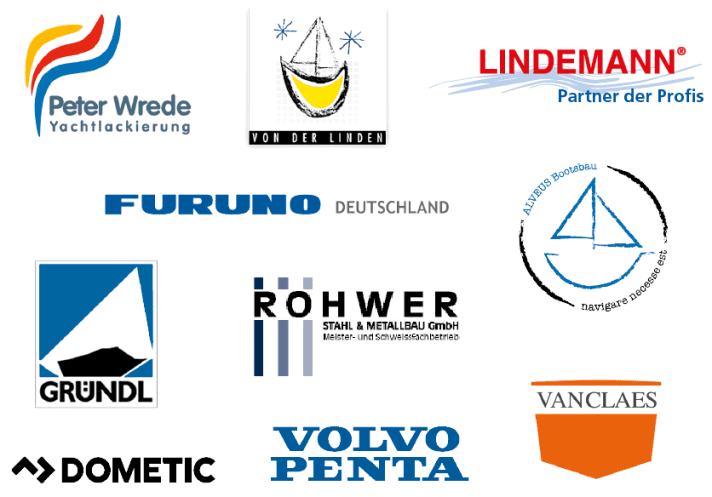





All episodes of the refit project:
- Part 1: Stocktaking
- Part 2: Replacing the rear view mirror
- Part 3: The underwater hull
- Part 4: GRP repairs
- Part 5: Antifouling coating
- Part 6: The motor foundation
- Part 7: The stringer system
- Part 8: The new engine
- Part 9: The new tank
- Part 10: The new tank
- Part 11: The interior work continues
- Part 12: The side panelling
- Part 13: Surface treatment and colour
The engine and sterndrive are installed and the new stainless steel tank is fitted and connected. Time for the interior work on our Conquest 1950 CC. So off we go to Potsdam to Fritz-Zubell-Straße. Sven Walter, boat builder at M. u. H von der Linden, and Alveus boatbuilding boss Hilmar Dembler-Malik and his team are waiting for us here. As always, the refit professionals, who have been supporting us with advice and even more help since the start of our project, have a plan. They first want to "protect" the brand new engine and therefore start with the interior work on our Cuddy Cabin aft.
The (art) craftsmen want to move safely during their work and therefore measure the new cockpit floor made of Coosa composite panels in the first work step. For your information: Coosa panels are made from a polyurethane foam filled with continuous glass fibres, which is additionally reinforced with glass roving fabric. They never rot, are super light, extremely strong and last forever and three days. The measurements taken in the boat are then transferred to the Coosa panels and these are then cut to size using an electric circular saw.
The remains of the old floor must be completely removed
Rebates (edges) are milled into the cut floor panels, into which a bracket made of glass fibre reinforced plastic (GRP) is glued flush with epoxy adhesive. The prefabricated GRP bracket is intended to guide the engine box to the side and also prevent spray or rainwater from running into the engine bilge (the lowest space in the boat).
Before the Coosa floor is installed in the boat, the "flanges" of the old cockpit floor must be completely removed. Even if a machine helps, this cannot be done without real manual labour. The new floor panels, which are glued to the stringers on the underside and laminated to the side walls and transom during final assembly, can then be fitted and fixed in place with Spax screws. This way, if there is a "jam" anywhere, everything can simply be removed again and repaired.
Once the floor is in place, the cockpit rear wall is sketched out on a large Coosa panel, cut to size and fitted. If everything is correct, all that remains to be done before assembly with epoxy adhesive and laminate is to cut out the two hatches for the storage space and engine compartment ventilation and reinforce the back of the wall with glued-on Coosa strips. The engine box is on the boat builders' agenda before the final stage.
The plan: reclining seats, double bench seat and a minibar for the refit boat
One thing is clear: you and we don't want a sunbathing area. On a boat of this size (6.15 metres long and 2.41 metres wide), it's always a size too small anyway and therefore uncomfortable. The boat builders want to make the whole thing practical. In other words, they want to be able to walk and stand next to the engine box during mooring and anchoring manoeuvres, making it easy to operate the cleats. Their construction plan shows two comfortable seats with a deckchair feel, i.e. with sloping backrests, next to the engine box. There is to be a small double bench seat in front of the box "for people who like each other" and a minibar on top of the box. The profile of the engine box is to be rounded and used as a comfortable backrest and storage space.
To make it round, the refit professionals cut transverse joints in a DuFlex sandwich panel (a panel made from Bals brainwood or PVC foam core with epoxy laminate). The side walls are made from the same material and adapted to the curves of the "roof construction". Once the cuts are ready, everything is "tried on". A small correction here, a small correction there. At the second attempt, everything fits perfectly and the transverse joints can be filled with adhesive - a mixture of epoxy resin, hardener and filler - and the roof and side walls can be glued together. Any adhesive that is squeezed out is smoothed out with a plastic spatula. Otherwise, screw clamps ensure that nothing slips when the adhesive hardens. After the drying phase, the seams are laminated over. This prevents "loose contacts".
Everything okay? The final "stand test" in the cockpit shows that the seats next to the engine box are not wide enough for "XL-sized seats". The Alveus team is currently looking for solutions. We are curious.
Video of the refit project
The BOOTE Refit project is supported by


